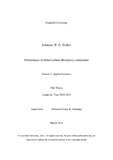JavaScript is disabled for your browser. Some features of this site may not work without it.
| dc.contributor.advisor | Partridge, Ivana K. | |
| dc.contributor.author | Treiber, Johannes W. G. | |
| dc.date.accessioned | 2011-06-21T08:26:56Z | |
| dc.date.available | 2011-06-21T08:26:56Z | |
| dc.date.issued | 2011-03 | |
| dc.identifier.uri | http://dspace.lib.cranfield.ac.uk/handle/1826/5531 | |
| dc.description.abstract | The thesis presents a detailed analysis of the effects of one-sided access z-direction reinforcement, ‘tufting’, on the morphology and mechanical performance of the resulting MVR-444 epoxy matrix/carbon fibre fabric composites. The dry fabric architectures used are pseudo-UD, twill woven fabric and non-crimped fabric (NCF). They are tufted with a range of commercial tufting threads, using KSL KL150 tufting head mounted on a 6-axis robot arm. The main focus is on the use of a twisted carbon fibre thread, at areal tufting densities of 0.5% and 2%. The composite plates are prepared via Resin-Transfer- Moulding (RTM) route, making it possible to control the plate thicknesses. The morphological features characteristic of tufted, cured composites are described and categorised. The global and local fibre volume fractions are measured and simple models proposed that connect local increase with local fibre deviation and presence of resin rich surface loop layers. It is shown that the balance of in-plane and out-of-plane properties in tufted composites is highly dependent on the tufting parameters, but also on the fabric architecture, with the NCF option seeming the most attractive. Overall, the stiffness of tufted materials is not affected and the drop in in-plane strength of any realistic geometry combinations is below 20%. ‘Thread-less’ tufting experiments prove that the drop is not caused by fibre breakage from the passage of the needle alone. Digital image correlation (DIC) techniques is used to map out the strain field distributions during mechanical testing, increasing the accuracy of crack tip location in Mode II delamination cracking studies and confirming the mode mixity changes during deformation of tufted structures. Single-tuft experiments provide the experimental data that are required for the development and validation of analytical models. A finite element unit cell model is developed to predict in-plane elastic and failure behaviour of tufted UD and NCF composites incorporating the critical meso-structural features of fibre deviation and increased fibre volume fraction. The thesis also contains an overview of the tufting technology and some detailed information on recent manufacturing developments that were required to obtain the controlled quality specimens used in the study. A demonstration structural element was produced, in the form of a tufted omega-stiffener. A standard pull-off test demonstrates the superior load carrying and energy absorbing capacity of this strengthened structure. Details of robot programming, additional single tuft bridging results, test fixture design, derivation of the analytical bridging model and additional publications are given in appendices to the main body of the thesis. | en_UK |
| dc.language.iso | en | en_UK |
| dc.publisher | Cranfield University | en_UK |
| dc.rights | © Cranfield University, 2011. All rights reserved. No part of this publication may be reproduced without the written permission of the copyright holder | en_UK |
| dc.title | Performance of tufted carbin fibre/epoxy composites | en_UK |
| dc.type | Thesis or dissertation | en_UK |
| dc.type.qualificationlevel | Doctoral | en_UK |
| dc.type.qualificationname | PhD | en_UK |
